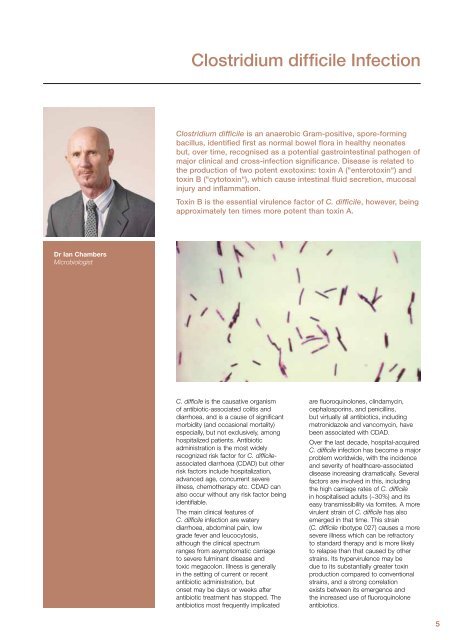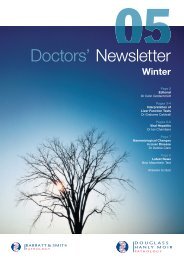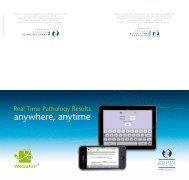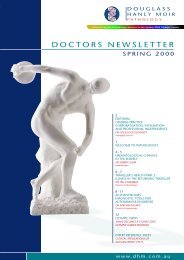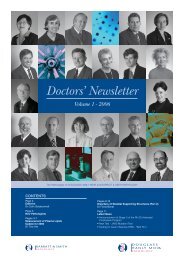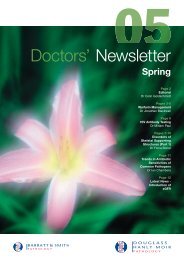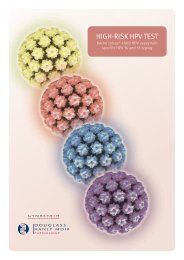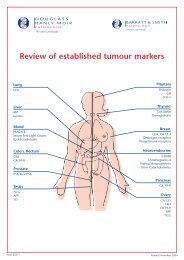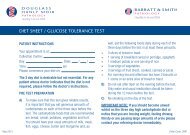New PathologistsDR LISA LIN MB, BS, BSc (Med), FRCPASpecialty: HistopathologySpecial interests: Breast and genitourinaryDr Lisa Lin graduated from University of New South Wales in 2004 and completed her internship andresidency training at Royal Prince Alfred Hospital, Sydney. She commenced her anatomical pathologytraining at John Hunter Hospital, Newcastle, in 2007, after which her training was predominantlybased at Westmead Hospital, Sydney. Dr Lin also gained experience working at different public andprivate laboratories through rotations to <strong>Douglass</strong> <strong>Hanly</strong> <strong>Moir</strong> <strong>Pathology</strong>, Royal North Shore andNepean Hospitals and the Department of Forensic Medicine, Glebe. During her training, Dr Lin hasbeen involved in a number of publications in peer-review journal articles, and also co-authored atextbook chapter. She has special interests in breast, genitourinary and gynaecological pathology.DR SCOTT MEAD MSc (Hons), PhD, MBChB, BHB, FRCPASpecial interest: Genetic pathologyDr Scott Mead graduated from the University of Auckland (New Zealand) where he also gained a PhDin Molecular Medicine. His pathology training was undertaken at Christchurch School of Medicine(University of Otago) and Royal Prince Alfred Hospital, Sydney. Dr Mead has a long-standing interestin cancer genetics and is currently researching the clinical application of personal cancer genomesequencing at the Kinghorn Cancer Centre (Garvan Institute). He is also involved in targeted oncologytesting at SydPath <strong>Pathology</strong> (St Vincent’s Hospital). Dr Mead is currently aConjoint Senior Lecturer atthe School of Medical Sciences, University of NSW.DR CRAIG WALLINGTON-BEDDOE BSc (Hons), MB, BS (Hons), FRACP, FRCPASpeciality: HaematologySpecial interests: Malignant haematology, flow cytometry and molecular geneticsDr Craig Wallington-Beddoe graduated with a medical degree from the University of Sydney in2001. During his early medical training, he developed an interest in haematology and undertookpostgraduate clinical and laboratory haematology training at Prince of Wales and WestmeadHospitals for the awards of FRACP and FRCPA in 2010. Dr Wallington-Beddoe is currentlycompleting his PhD studies in acute lymphoblastic leukaemia (ALL) research at the WestmeadMillennium Institute, the University of Sydney. His study is investigating the function of enzymescalled sphingosine kinases in maintaining viable ALL cells and attempting to exploit these enzymesand their associated intracellular signalling pathways to provide a novel approach to treating ALL.Dr Wallington-Beddoe joined <strong>Douglass</strong> <strong>Hanly</strong> <strong>Moir</strong>’s haematology department in November 2011.His interests are in malignant haematology, with a particular focus on leukaemias and lymphoidneoplasms, and he is familiar with a wide range of laboratory techniques and their applications toclinical haematology.DR MICHAEL WEHRHAHN BSc (Med), MB, BS (Hons), MPH (Hons), FRACP, FRCPASpecialty: MicrobiologySpecial interests: Clinical infectious diseases and diagnostic microbiologyAfter graduating from the University of NSW in 1999, Dr Michael Wehrhahn completed a Master ofPublic Health at the University of Sydney before commencing training in Clinical Microbiology andInfectious Diseases in Perth, in 2005. Experience gained at Royal Perth, Fremantle and PrincessMargaret Hospitals was complemented by appointments at Liverpool, Royal North Shore andWestmead Hospitals, where he completed his training in mid-2011.Dr Wehrhahn has developed several specific interests and areas of expertise. For the last twoyears, he has worked as a clinical mentor to HIV providers in the Highlands of Papua New Guinea,in addition to maintaining research interests in the clinical and laboratory features of communityassociatedMRSA, novel diagnostic methods for identifying fastidious bacteria and identifyingpreventable factors associated with health-care associated infections.He holds a current appointment as Adjunct Lecturer at the University of Notre Dame, Sydney.4
Clostridium difficile InfectionClostridium difficile is an anaerobic Gram-positive, spore-formingbacillus, identified first as normal bowel flora in healthy neonatesbut, over time, recognised as a potential gastrointestinal pathogen ofmajor clinical and cross-infection significance. Disease is related tothe production of two potent exotoxins: toxin A ("enterotoxin") andtoxin B ("cytotoxin"), which cause intestinal fluid secretion, mucosalinjury and inflammation.Toxin B is the essential virulence factor of C. difficile, however, beingapproximately ten times more potent than toxin A.Dr Ian ChambersMicrobiologistC. difficile is the causative organismof antibiotic-associated colitis anddiarrhoea, and is a cause of significantmorbidity (and occasional mortality)especially, but not exclusively, amonghospitalized patients. Antibioticadministration is the most widelyrecognized risk factor for C. difficileassociateddiarrhoea (CDAD) but otherrisk factors include hospitalization,advanced age, concurrent severeillness, chemotherapy etc. CDAD canalso occur without any risk factor beingidentifiable.The main clinical features ofC. difficile infection are waterydiarrhoea, abdominal pain, lowgrade fever and leucocytosis,although the clinical spectrumranges from asymptomatic carriageto severe fulminant disease andtoxic megacolon. Illness is generallyin the setting of current or recentantibiotic administration, butonset may be days or weeks afterantibiotic treatment has stopped. Theantibiotics most frequently implicatedare fluoroquinolones, clindamycin,cephalosporins, and penicillins,but virtually all antibiotics, includingmetronidazole and vancomycin, havebeen associated with CDAD.Over the last decade, hospital-acquiredC. difficile infection has become a majorproblem worldwide, with the incidenceand severity of healthcare-associateddisease increasing dramatically. Severalfactors are involved in this, includingthe high carriage rates of C. difficilein hospitalised adults (~30%) and itseasy transmissibility via fomites. A morevirulent strain of C. difficile has alsoemerged in that time. This strain(C. difficile ribotype 027) causes a moresevere illness which can be refractoryto standard therapy and is more likelyto relapse than that caused by otherstrains. Its hypervirulence may bedue to its substantially greater toxinproduction compared to conventionalstrains, and a strong correlationexists between its emergence andthe increased use of fluoroquinoloneantibiotics.5


